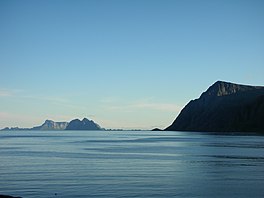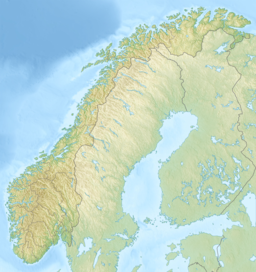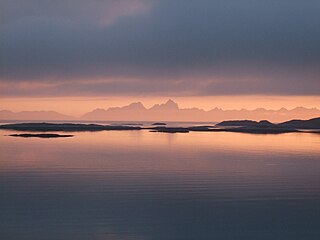
The Norwegian Sea is a marginal sea, grouped with either the Atlantic Ocean or the Arctic Ocean, northwest of Norway between the North Sea and the Greenland Sea, adjoining the Barents Sea to the northeast. In the southwest, it is separated from the Atlantic Ocean by a submarine ridge running between Iceland and the Faroe Islands. To the north, the Jan Mayen Ridge separates it from the Greenland Sea.

"A Descent into the Maelström" is an 1841 short story by American writer Edgar Allan Poe. In the tale, a man recounts how he survived a shipwreck and a whirlpool. It has been grouped with Poe's tales of ratiocination and also labeled an early form of science fiction.

Værøy is an island municipality in Nordland county, Norway. It is part of the traditional district of Lofoten. The administrative centre of the municipality is the village of Sørland on the main island of Værøya. The other village in Værøy is Nordland. Most of the residents live in the Sørland area surrounding the main harbor. The old Værøy Lighthouse sits at the end of that harbor.

Flakstad is a municipality in Nordland county, Norway. It is part of the traditional district of the island group Lofoten. The administrative centre of the municipality is the village of Ramberg.

Moskenes is a municipality in Nordland county, Norway. The municipality comprises the southern part of the island of Moskenesøya in the traditional district of Lofoten. The administrative centre of the municipality is the village of Reine. Other villages include Sørvågen, Hamnøy, and Å.
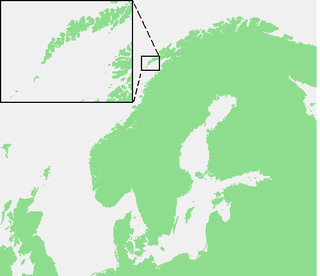
Operation Anklet was the codename given to a British Commando raid during the Second World War. The raid on the Lofoten Islands was carried out in December 1941, by 300 men from No. 12 Commando and the Norwegian Independent Company 1. The landing party was supported by 22 ships from three navies.

A whirlpool is a body of rotating water produced by opposing currents or a current running into an obstacle. Small whirlpools form when a bath or a sink is draining. More powerful ones formed in seas or oceans may be called maelstroms. Vortex is the proper term for a whirlpool that has a downdraft.
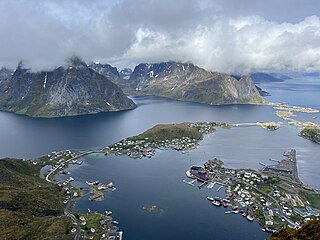
Lofoten is an archipelago and a traditional district in the county of Nordland, Norway. Lofoten has distinctive scenery with dramatic mountains and peaks, open sea and sheltered bays, beaches and untouched lands. There are two towns, Svolvær and Leknes – the latter is approximately 169 km (105 mi) north of the Arctic Circle and approximately 2,420 km (1,500 mi) away from the North Pole. The archipelago experiences one of the world's largest elevated temperature anomalies relative to its high latitude.
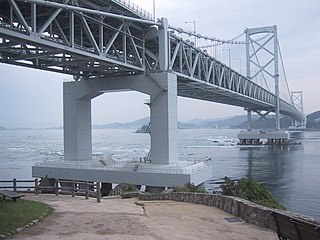
The Naruto whirlpools are tidal whirlpools in the Naruto Strait, a channel between Naruto in Tokushima and Awaji Island in Hyōgo, Japan. The strait between Naruto and Awaji island has a width of about 1.3 km. The strait is one of the connections between the Pacific Ocean and the Inland Sea, a body of water separating Honshū and Shikoku, two of the main islands of Japan. The tide moves large amounts of water into and out of the Inland Sea twice a day. With a range of up to 1.7 m (5.6 ft), the tide creates a difference in the water level of up to 1.5 m between the Inland Sea and the Pacific. Due to the narrowness of the strait, the water rushes through the Naruto channel at a speed of about 13–15 km/h (8–9 mph) four times a day, twice flowing in and twice flowing out. During a spring tide, the speed of the water may reach 20 km/h (12 mph), creating vortices up to 20 m (66 ft) in diameter.
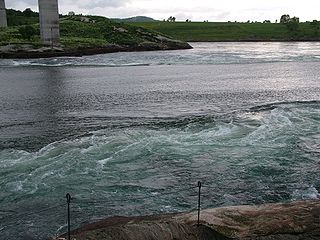
Saltstraumen is a small strait with one of the strongest tidal currents in the world. It is located in the municipality of Bodø in Nordland county, Norway. It is located about 10 km (6.2 mi) southeast of the town of Bodø. The narrow channel connects the outer Saltfjorden to the large Skjerstad Fjord between the islands of Straumøya and Knaplundsøya. The Saltstraumen Bridge on Norwegian County Road 17 crosses Saltstraumen.
Old Sow is the largest tidal whirlpool in the Western Hemisphere, located off the southwestern shore of Deer Island, New Brunswick, Canada, and off the northeast shore of Moose Island, the principal island of Eastport, Maine.

The Gulf of Corryvreckan, also called the Strait of Corryvreckan, is a narrow strait between the islands of Jura and Scarba, in Argyll and Bute, off the west coast of mainland Scotland.

Ynys Gored Goch, sometimes Ynys Gorad Goch, is a small island in the Menai Strait between Gwynedd and Anglesey in north Wales. It is situated in the stretch of the strait called the Swellies between Thomas Telford's Menai Suspension Bridge and Robert Stephenson's Britannia Bridge.

Vestfjorden is a 155-kilometre (96 mi) long fjord or oceanic sea in Nordland county, Norway.

Moskenesøya is an island at the southern end of the Lofoten archipelago in Nordland county, Norway. The 186-square-kilometre (72 sq mi) island is shared between Moskenes Municipality and Flakstad Municipality. The tidal whirlpool system known as Moskstraumen, one of the strongest in the world, is located between Moskenesôya's Lofoten Point and the island of Mosken.

Mosken is a small uninhabited rocky island in Værøy Municipality in Nordland county, Norway. The 1.5-square-kilometre (0.58 sq mi) island is located in the Lofoten archipelago about halfway between the islands of Værøya to the south and Moskenesøya to the north. The Moskenstraumen maelstrom—one of the most powerful in the world—is located on the north side of the island of Mosken. Historically, the island was used for grazing sheep in both the summer and the winter.

Glåpen Lighthouse is a coastal lighthouse in Moskenes Municipality in Nordland county, Norway. The lighthouse sits on the southeastern shore of the island of Moskenesøya, just south of the village of Sørvågen on the northern coast of the Vestfjorden.
Værøya or Værøy is an island in Værøy Municipality in Nordland county, Norway. The 15.7-square-kilometre (6.1 sq mi) island makes up about 89% of the land area of the whole municipality and it is home to 100% of the municipal residents.

Lofotodden National Park is a Norwegian national park located in Moskenes and Flakstad municipalities in Nordland. It is located not far from the Arctic Circle on the island of Moskenesøya in the Lofoten archipelago.
